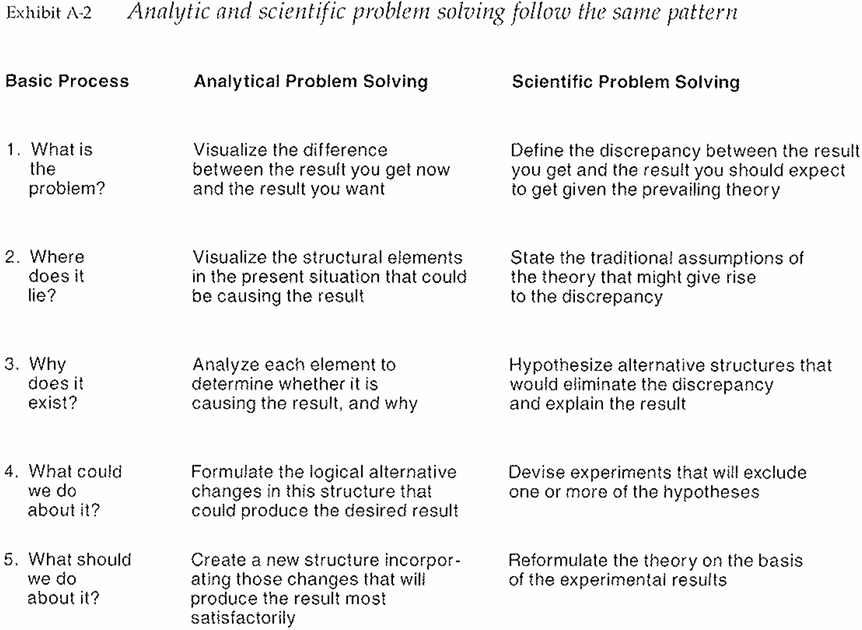


 Grammar
Grammar
 Tenses
Tenses
 Present
Present
 Past
Past
 Future
Future
 Parts Of Speech
Parts Of Speech
 Nouns
Nouns
 Verbs
Verbs
 Adverbs
Adverbs
 Adjectives
Adjectives
 Pronouns
Pronouns
 Pre Position
Pre Position
 Preposition by function
Preposition by function 
 Preposition by construction
Preposition by construction
 Conjunctions
Conjunctions
 Interjections
Interjections
 Grammar Rules
Grammar Rules
 Linguistics
Linguistics
 Semantics
Semantics
 Pragmatics
Pragmatics
 Reading Comprehension
Reading Comprehension|
Read More
Date: 2024-09-26
Date: 2024-09-26
Date: 2024-09-11
|
Once the hypothesis is formulated, the next step is to use it to suggest experiments that will confirm or deny it. Again, visual thinking is required to say, "If this structure were valid, what would follow as a matter of course? Let me set up an experiment to prove conclusively that in fact it does follow." To put it in terms of the Abductive process:
Result I observe the unexpected fact A
Rule A may be so because B is the case
Case If B were the case, then C would follow as a matter of course. Let me check whether C does in fact follow
We can see the process very easily in the story of Galileo and the cannonball:
Result Aristotle says that force is that which produces velocity. From this it follows that when a force ceases to act on a body, the body should cease to move. Yet if I shoot a ball front a cannon, the ball continues to move even though the force has stopped. Aristotle must be wrong in his conception of force as it relates to motion.
Rule I can observe the relationship between motion and force simply by dropping a ball from my hand. When f do so I notice that the situation contains three structural elements:
The weight of the ball
The distance through which it falls.
The time through which it falls.
This suggests three different hypotheses:
1. Force is proportional to the weight of the body on which the force acts
2. Force is proportional to the distance through which the body moves when the force acts
3. Force is proportional to the time through which the force acts.
Case If hypothesis three is true, then the distance covered would be proportional to the square of the time. This means that if a body covers one unit of distance in one unit of time, it must cover four units of distance in two units of time, nine units of distance in three units of time, etc.
Let me roll a ball down the side of an inclined plane. This ·will slow up its fall sufficiently for me to measure the distance covered in different units of time, and thus determine whether the relation between distance and time is the one prescribed by my hypothesis.
New Rule It is the same. Therefore force is that which produces change of velocity.
The trick in structuring an experiment is to make sure that it will yield a clear-cut, yes-or-no answer. It is not enough to "see what happens" if you change one or another of the conditions in the situation. The result of the experiment must allow you to state unequivocally whether you will keep or discard the hypothesis.
It is in the sciences that have most rigorously applied this particular requirement that the greatest advances in our knowledge have occurred over the last 80 years. To quote Charles Darwin:
How odd it is that anyone should not see that all observations must be for or against some view, if they are to be of any service.
To bring this discussion to a close, I have set out below both forms of Abduction. As you can see, they follow a common pattern. It is a pattern that can be of enormous value in guiding you to produce rapid breakthroughs in thinking about and resolving problems. Its value lies in the fact that it forces your thinking forward in a rigorous way, in the minimum sequence of steps, without dawdling or getting tied up in irrelevancies.
Each step demands a clear end product that you can literally see; each image indicates the direction in which the subsequent analyses should lead. When the problem has been solved, the images serve as anchors to guide the course of your discussion and the choice of your words.

Herb Simon says that solving a problem simply means representing it so as to make the solution transparent. I have striven to give you an understanding of the process by which such representations can most efficiently be created and utilized. We are all probably capable of thinking far more creatively and efficiently than we ever attempt. Clearer knowledge of the process involved might influence us to try.
|
|
|
|
دراسة تحدد أفضل 4 وجبات صحية.. وأخطرها
|
|
|
|
|
|
|
العتبة العباسية تستعدّ لتكريم عددٍ من الطالبات المرتديات للعباءة الزينبية في جامعات كركوك
|
|
|